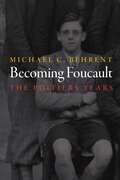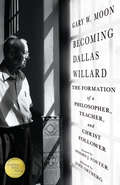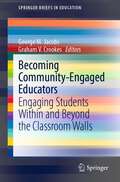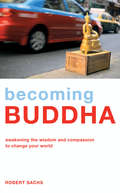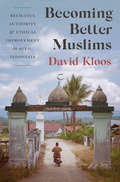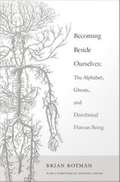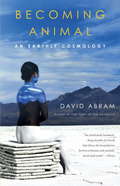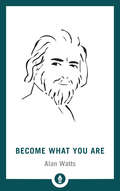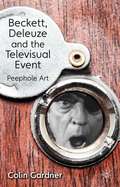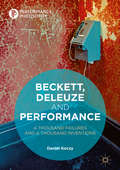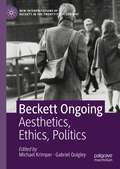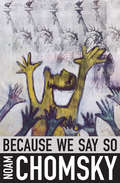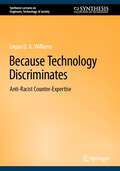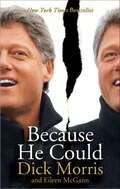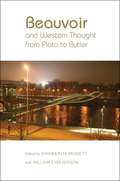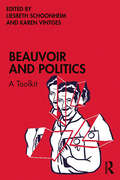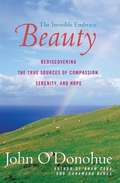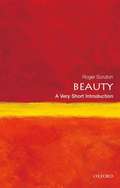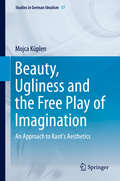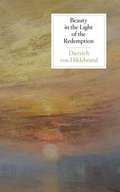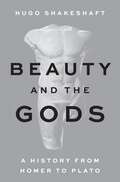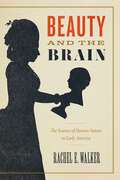- Table View
- List View
Becoming Foucault: The Poitiers Years (Intellectual History of the Modern Age)
by Michael C. BehrentThough Michel Foucault is one of the most important thinkers of the twentieth century, little is known about his early life. Even Foucault’s biographers have neglected this period, preferring instead to start the story when the future philosopher arrives in Paris.Becoming Foucault is a historical reconstruction of the world in which Foucault grew up: the small city of Poitiers, France, from the 1920s until the end of the Second World War. Beyond exploring previously unexamined aspects of Foucault’s childhood, including his wartime ordeals, it proposes an original interpretation of Foucault’s oeuvre. Michael Behrent argues that Foucault, in addition to being a theorist of power, knowledge, and selfhood, was also a philosopher of experience. He was a thinker intent on making sense of the events that he lived through. Behrent identifies four specific experiences in Foucault’s childhood that exercised a decisive influence on him and that, in various ways, he later made the subject of his philosophy: his family’s deep connections to the medical profession; his upbringing in a bourgeois household; the German Occupation during World War II; and his Catholic education.Behrent not only reconstructs the specific nature of these experiences but also shows how reference to them surfaces in Foucault’s later work. In this way, the book both sheds light on a formative period in the philosopher’s life and offers a unique interpretation of key aspects of his thought.
Becoming Dallas Willard: The Formation of a Philosopher, Teacher, and Christ Follower
by Richard J. Foster Gary MoonDallas Willard was a personal mentor and inspiration to hundreds of pastors, philosophers, and average churchgoers. His presence and ideas rippled through the lives of many prominent leaders and authors, such as John Ortberg, Richard Foster, James Bryan Smith, Paula Huston, and J. P. Moreland. As a result of these relationships and the books he wrote, he fundamentally altered the way tens of thousands of Christians have understood and experienced the spiritual life. Whether great or small, everyone who met Dallas was impressed by his personal attention, his calm confidence, his wisdom, and his profound sense of the spiritual. But he was not always the man who lived on a different plane of reality than so many of the rest of us. He was someone who had to learn to be a husband, a parent, a teacher, a Christ follower. The journey was not an easy one. He absorbed some of the harshest and most unfair blows life can land. His mother died when he was two, and after his father remarried he was exiled from his stepmother’s home. Growing up in Depression-era, rural Missouri and educated in a one-room schoolhouse, he knew poverty, deprivation, anxiety, self-doubt, and depression. Though the pews he sat in during his early years were not offering much by way of love and mercy, Dallas, instead of turning away, kept looking for the company of a living, present, and personal God. In Gary W. Moon’s candid and inspiring biography, we read how Willard became the person who mentored and partnered with his young pastor, Richard Foster, to inspire some of the most influential books on spirituality of the last generation. We see how his love of learning took him on to Baylor, the University of Wisconsin, and the University of Southern California, where he became a beloved professor and one of the most versatile members of the philosophy department. The life of Dallas Willard deserves attention because he became a person who himself experienced authentic transformation of life and character. Dallas Willard not only taught about spiritual disciplines, he became a different person because of them. He became a grounded person, a spiritually alive person as he put them into practice, finding God, as he often said, "at the end of his rope." Here is a life that gives us all hope.
Becoming Community-Engaged Educators: Engaging Students Within and Beyond the Classroom Walls (SpringerBriefs in Education)
by Graham V. Crookes George M. JacobsThis book puts forth a call to engagement for educators at all levels of education and in all subject areas, with a focus on language education. Through using a grounded theory approach, it features semi-structured interviews, in a qualitative approach, with educators who embody community engaged education. Each chapter encompasses a case study that examines the interviewee's motivations, strategies, successes and failures. This book presents a local theory of community-engaged teachers and researchers to assist educators in developing as a community-engaged teacher or researcher. It asks and attempts to answer critical questions concerning the initial induction into community engagement, the maintenance of energy, commitment, and motivation, and the role of support networks. Through these, this book examines what is needed to sustain such an identity, and support campaigns of action or individual engagement over both the short and long term.
Becoming Buddha
by Robert SachsTo "Become Buddha" is to AWAKE. We need to awake to our personal responsibility-not only for our own lives but for the world around us. Individual efforts can change the world. This book does not promise enlightenment but it will provide a path-a path that, if you follow it, will transform your life. Buddhist masters say that we are in a "Dark Age". Terrorist attacks, wars, economic failures, and natural disasters have created an atmosphere of fear. Tibetan masters encourage us not to lose heart-catastrophes have happened before and we have overcome them. Robert Sachs shows how Tibetan Buddhist teachings can have a real influence on our personal lived and equally on contemporary politics. He presents the four thoughts that revolutionize the mind, and demonstrates how we must take personal responsibility for the future. The Four Noble Truths show us there is no need to despair; and the four components of action will change our attitude to life and give us practical instruction on how to act. Using the power of meditation to make a difference, we can turn the inherent goodness of the human race into positive energy to help transform the world. The Venerable Chogyam Trungpa Rinpoche used to say, "A mind that is transformed, free and cheerful can help create peace and happiness. Let us start down the path from this very moment."
Becoming Better Muslims: Religious Authority and Ethical Improvement in Aceh, Indonesia
by David KloosHow do ordinary Muslims deal with and influence the increasingly pervasive Islamic norms set by institutions of the state and religion? Becoming Better Muslims offers an innovative account of the dynamic interactions between individual Muslims, religious authorities, and the state in Aceh, Indonesia. Relying on extensive historical and ethnographic research, David Kloos offers a detailed analysis of religious life in Aceh and an investigation into today’s personal processes of ethical formation.Aceh is known for its history of rebellion and its recent implementation of Islamic law. Debunking the stereotypical image of the Acehnese as inherently pious or fanatical, Kloos shows how Acehnese Muslims reflect consciously on their faith and often frame their religious lives in terms of gradual ethical improvement. Revealing that most Muslims view their lives through the prism of uncertainty, doubt, and imperfection, he argues that these senses of failure contribute strongly to how individuals try to become better Muslims. He also demonstrates that while religious authorities have encroached on believers and local communities, constraining them in their beliefs and practices, the same process has enabled ordinary Muslims to reflect on moral choices and dilemmas, and to shape the ways religious norms are enforced.Arguing that Islamic norms are carried out through daily negotiations and contestations rather than blind conformity, Becoming Better Muslims examines how ordinary people develop and exercise their religious agency.
Becoming Beside Ourselves: The Alphabet, Ghosts, and Distributed Human Being
by Brian RotmanBecoming Beside Ourselves continues the investigation that the renowned cultural theorist and mathematician Brian Rotman began in his previous books Signifying Nothing and Ad Infinitum. . . The Ghost in Turing's Machine: exploring certain signs and the conceptual innovations and subjectivities that they facilitate or foreclose. In Becoming Beside Ourselves, Rotman turns his attention to alphabetic writing or the inscription of spoken language. Contending that all media configure what they mediate, he maintains that alphabetic writing has long served as the West's dominant cognitive technology. Its logic and limitations have shaped thought and affect from its inception until the present. Now its grip on Western consciousness is giving way to virtual technologies and networked media, which are reconfiguring human subjectivity just as alphabetic texts have done for millennia. Alphabetic texts do not convey the bodily gestures of human speech: the hesitations, silences, and changes of pitch that infuse spoken language with affect. Rotman suggests that by removing the body from communication, alphabetic texts enable belief in singular, disembodied, authoritative forms of being such as God and the psyche. He argues that while disembodied agencies are credible and real to "lettered selves," they are increasingly incompatible with selves and subjectivities formed in relation to new virtual technologies and networked media. Digital motion-capture technologies are restoring gesture and even touch to a prominent role in communication. Parallel computing is challenging the linear thought patterns and ideas of singularity facilitated by alphabetic language. Barriers between self and other are breaking down as the networked self is traversed by other selves to become multiple and distributed, formed through many actions and perceptions at once. The digital self is going plural, becoming beside itself.
Becoming Animal
by David AbramDavid Abram's first book, The Spell of the Sensuous--hailed as "revolutionary" by the Los Angeles Times, as "daring and truly original" by Science--has become a classic of environmental literature. Now Abram returns with a startling exploration of our human entanglement with the rest of nature. As the climate veers toward catastrophe, the innumerable losses cascading through the biosphere make vividly evident the need for a metamorphosis in our relation to the living land. For too long we've inured ourselves to the wild intelligence of our muscled flesh, taking our primary truths from technologies that hold the living world at a distance. This book subverts that distance, drawing readers ever deeper into their animal senses in order to explore, from within, the elemental kinship between the body and the breathing Earth. The shapeshifting of ravens, the erotic nature of gravity, the eloquence of thunder, the pleasures of being edible: all have their place in Abram's investigation. He shows that from the awakened perspective of the human animal, awareness (or mind) is not an exclusive possession of our species but a lucid quality of the biosphere itself--a quality in which we, along with the oaks and the spiders, steadily participate. With the audacity of its vision and the luminosity of its prose, Becoming Animal sets a new benchmark for the human appraisal of our place in the whole.From the Hardcover edition.
Become What You Are: Expanded Edition
by Alan W. Watts"Life exists only at this very moment, and in this moment it is infinite and eternal. For the present moment is infinitely small; before we can measure it, it has gone, and yet it exists forever. . . . You may believe yourself out of harmony with life and its eternal Now; but you cannot be, for you are life and exist Now."--from Become What You Are In this collection of writings, including nine new chapters never before available in book form, Watts displays the intelligence, playfulness of thought, and simplicity of language that has made him so perennially popular as an interpreter of Eastern thought for Westerners. He draws on a variety of religious traditions, and covers topics such as the challenge of seeing one's life "just as it is," the Taoist approach to harmonious living, the limits of language in the face of ineffable spiritual truth, and the psychological symbolism of Christian thought.
Beckett, Deleuze and the Televisual Event
by Colin GardnerAn expressive dialogue between Deleuze's philosophical writings on cinema and Beckett's innovative film and television work, the book explores the relationship between the birth of the event - itself a simultaneous invention and erasure - and Beckett's attempts to create an incommensurable space within the interstices of language as a (W)hole.
Beckett, Deleuze and Performance: A Thousand Failures and A Thousand Inventions (Performance Philosophy)
by Daniel KoczyThis book draws on the theatrical thinking of Samuel Beckett and the philosophy of Gilles Deleuze to propose a method for research undertaken at the borders of performance and philosophy. Exploring how Beckett fabricates encounters with the impossible and the unthinkable in performance, it asks how philosophy can approach what cannot be thought while honouring and preserving its alterity. Employing its method, it creates a series of encounters between aspects of Beckett’s theatrical practice and a range of concepts drawn from Deleuze’s philosophy. Through the force of these encounters, a new range of concepts is invented. These provide novel ways of thinking affect and the body in performance; the possibility of theatrical automation; and the importance of failure and invention in our attempts to respond to performance encounters. Further, this book includes new approaches to Beckett’s later theatrical work and provides an overview of Deleuze’s conception of philosophical practice as an ongoing struggle to think with immanence.
Beckett's Art of Mismaking
by Leland de la DurantayeLeland de la Durantaye helps us understand Beckett's strangeness and notorious difficulty by arguing that Beckett's lifelong campaign was to mismake on purpose--not to denigrate himself, or his audience, or reconnect with the child or savage within, but because he believed that such mismaking is in the interest of art and will shape its future.
Beckett Ongoing: Aesthetics, Ethics, Politics (New Interpretations of Beckett in the Twenty-First Century)
by Michael Krimper Gabriel Quigley“You must go on. I can’t go on. I’ll go on.” These are some of the most quoted lines written by Samuel Beckett, which speak to the impulse of persevering in times of crisis and impossibility. Yet few readers of Beckett agree about what this paradoxical formula could mean, let alone what mode of engagement it would seem to indicate, be it committed, autonomous, or something else entirely. This volume of essays explores what that mode of engagement could be, all the while elucidating the ethical and political stakes of the “ongoing” in both Beckett’s life and work. Across multiple disciplines in the humanities, the authors delve into questions of political subjectivity and representation, the ethics of powerlessness and refusal, the aesthetics of syncopation and destitution, multimedia experiments between genre, as well as Beckett’s wider impact on transnational itineraries of modernism and philosophy up to the contemporary.
Because We Say So
by Noam Chomsky Henry A. Giroux"Chomsky is a global phenomenon . . . perhaps the most widely read voice on foreign policy on the planet."--New York Times Book Review"Unwavering political contrarian Noam Chomsky smart-bombs the US military's global Interventions. Shock and awe!"--Vanity FairBecause We Say So presents more than thirty concise, forceful commentaries on US politics and global power. Written between 2011 and 2015, Noam Chomsky's arguments forge a persuasive counter-narrative to official accounts of US politics and policies during global crisis. Find here classic Chomsky on the increasing urgency of climate change, the ongoing impact of Edward Snowden's whistleblowing, nuclear politics, cyberwar, terrorism, Iraq, Afghanistan, Iran, Israel, and the Middle East, security and state power, as well as deeper reflections on the Obama doctrine, political philosophy, the Magna Carta, and the importance of a commons to democracy.Because We Say So is the third in a series of books by Chomsky published by City Lights Publishers that includes Making the Future (2012) and Interventions (2007), a book banned by US military censors. Taken together, the three books present a complete collection of the articles Chomsky writes regularly for the New York Times Syndicate, and are largely ignored by newspapers in the United States. Because We Say So offers fierce, accessible, timely, gloves-off political writing by America's foremost public intellectual and political dissident.Noam Chomsky is one of the world's most well-known critics of US policy. He has published numerous groundbreaking and best-selling books on global politics, history, and linguistics.
Because Technology Discriminates: Anti-Racist Counter-Expertise (Synthesis Lectures on Engineers, Technology, & Society #27)
by Logan D. WilliamsEngineers designing technologies and systems produce problems when they do not account for existing biases in society. Designers have a mandate to make technologies efficiently, economically, and ethically. This textbook is written for both students and practicing designers, engineers, researchers, or artists who want to create more ethical designs; it aims to help readers understand how race is implicated in technology design. Learning from historical and contemporary case studies of engineering and architecture projects will help readers see clearly the power of design decisions to either perpetuate or contest racism. Chapter exercises will change engineers’ mental models to see the bias inherent to existing technological design. By incorporating the knowledge and insights of community-based experts into design projects, readers will begin to practice anti-racist leadership and counter-expertise.
Because He Could
by Dick Morris Eileen McGannWho is Bill Clinton?A man whose presidency was disgraced by impeachment -- yet who remains one of the most popular presidents of our time.A man whose autobiography, My Life, was panned by critics as a self-indulgent daily diary -- but rode the bestseller lists for months.A man whose policies changed America at the close of the twentieth century -- yet whose weakness left us vulnerable to terror at the dawn of the twenty-first.No one better understands the inner Bill Clinton, that creature of endless and vexing contradiction, than Dick Morris. From the Arkansas governor's races through the planning of the triumphant 1996 reelection, Morris was Clinton's most valued political adviser. Now, in the wake of Clinton's million-selling memoir My Life, Morris and his wife, Eileen McGann, set the record straight with Because He Could, a frank and perceptive deconstruction of the story Clinton tells -- and the many more revealing stories he leaves untold.With the same keen insight they brought to Hillary Clinton's life in their recent bestseller Rewriting History, Morris and McGann uncover the hidden sides of the complicated and sometimes dysfunctional former president. Whereas Hillary is anxious to mask who she really is, they show, Bill Clinton inadvertently reveals himself at every turn -- as both brilliant and undisciplined, charming yet often filled with rage, willing to take wild risks in his personal life but deeply reluctant to use the military to protect our national security. The Bill Clinton who emerges is familiar -- reflexively blaming every problem on right-wing persecutors or naïve advisers -- but also surprising: passive, reactive, working desperately to solve a laundry list of social problems yet never truly grasping the real thrust of his own presidency. And while he courted danger in his personal life, the authors argue that Clinton's downfall has far less to do with his private demons than with his fear of the one person who controlled his future: his own first lady.Sharp and stylishly written, full of revealing insider anecdotes, Because He Could is a fresh and probing portrait of one of the most fascinating, and polarizing, figures of our time.
Beauvoir and Western Thought from Plato to Butler
by Shannon M. Mussett William S. WilkersonDespite a deep familiarity with the philosophical tradition and despite the groundbreaking influence of her own work, Simone de Beauvoir never embraced the idea of herself as a philosopher. Her legacy is similarly complicated. She is acclaimed as a revolutionary thinker on issues of gender, age, and oppression, but although much has been written weighing the influence she and Jean-Paul Sartre had on one another, the extent and sophistication of her engagement with the Western tradition broadly goes mostly unnoticed. This volume turns the spotlight on exactly that, examining Beauvoir's dialogue with her influences and contemporaries, as well as her impact on later thinkers—concluding with an autobiographical essay by bell hooks discussing the influence of Beauvoir's philosophy and life on her own work and career. These innovative essays both broaden our understanding of Beauvoir and suggest new ways of understanding canonical figures through the lens of her work.
Beauvoir and Politics: A Toolkit
by Liesbeth Schoonheim Karen VintgesApproaching Simone de Beauvoir’s feminism and social commentary as a resource to understand our current crises, Beauvoir and Politics: A Toolkit brings together established and emerging scholars to apply her insights to gender studies, political philosophy, decolonisation, intellectual history, age theory, and critical phenomenology. The essays in this collection start from key concepts in Beauvoir’s oeuvre and relate them to contemporary debates, asking how her notion of ambiguity speaks to lived experiences that have been highly politicized in recent years, such as pregnancy, old age, sexual violence, and the exposure of black and brown bodies to police violence; how myths inform our notions of collective, national identities, as well as notions of masculinity and femininity; and how she provides conceptual tools that help to theorize the various political strategies that are used to challenge gendered and racialized systems of oppression. These and other issues are central to this critical appraisal of Beauvoir’s legacy, demonstrating the contemporary relevance of her thought as it diagnoses the present and looks toward change for a better future. This book will be of great interest to undergraduate and postgraduate students looking to engage with the political content of Simone de Beauvoir’s work and the timely application of her ideas.
Beauty: The Invisible Embrace
by John O'DonohueBeauty does not linger, it only visits. <p><p> Yet beauty's visitation affects us and invites us into its rhythm, <p> it calls us to feel, think, and act beautifully in the world: <p> to create and live a life that awakens the Beautiful. <p> Beauty is a gentle but urgent call to awaken. Bestselling author John O'Donohue opens our eyes, hearts, and minds to the wonder of our own relationship with beauty by exposing the infinity and mystery of its breadth. His words return us to the dignity of silence, profundity of stillness, power of thought and perception, and the eternal grace and generosity of beauty's presence. In this masterful and revelatory work, O'Donohue encourages our greater intimacy with beauty and celebrates it for what it really is: a homecoming of the human spirit. As he focuses on the classical, medieval, and Celtic traditions of art, music, literature, nature, and language, O'Donohue reveals how beauty's invisible embrace invites us toward new heights of passion and creativity even in these uncertain times of global conflict and crisis.
Beauty: A Very Short Introduction
by Roger ScrutonBeauty can be consoling, disturbing, sacred, profane; it can be exhilarating, appealing, inspiring, chilling. It can affect us in an unlimited variety of ways. Yet it is never viewed with indifference. In this Very Short Introduction, the renowned philosopher Roger Scruton explores the concept of beauty, asking what makes an object--either in art, in nature, or the human form--beautiful, and examining how we can compare differing judgments of beauty when it is evident all around us that our tastes vary so widely. Is there a right judgment to be made about beauty? Is it right to say there is more beauty in a classical temple than a concrete office block, more in a Rembrandt than in an Andy Warhol Campbell Soup Can? Forthright and thought-provoking, and as accessible as it is intellectually rigorous, this introduction to the philosophy of beauty draws conclusions that some may find controversial, but, as Scruton shows, help us to find greater sense of meaning in the beautiful objects that fill our lives.
Beauty, Ugliness and the Free Play of Imagination: An Approach to Kant's Aesthetics (Studies in German Idealism #17)
by Mojca KüplenThis book presents a solution to the problem known in philosophical aesthetics as the paradox of ugliness, namely, how an object that is displeasing can retain our attention and be greatly appreciated. It does this by exploring and refining the most sophisticated and thoroughly worked out theoretical framework of philosophical aesthetics, Kant's theory of taste, which was put forward in part one of the Critique of the Power of Judgment. The book explores the possibility of incorporating ugliness, a negative aesthetic concept, into the overall Kantian aesthetic picture. It addresses a debate of the last two decades over whether Kant's aesthetics should allow for a pure aesthetic judgment of ugliness. The book critically reviews the main interpretations of Kant's central notion of the free play of imagination and understanding and offers a new interpretation of free play, one that allows for the possibility of a disharmonious state of mind and ugliness. In addition, the book also applies an interpretation of ugliness in Kant's aesthetics to resolve certain issues that have been raised in contemporary aesthetics, namely the possibility of appreciating artistic and natural ugliness and the role of disgust in artistic representation. Offering a theoretical and practical analysis of different kinds of negative aesthetic experiences, this book will help readers acquire a better understanding of his or her own evaluative processes, which may be helpful in coping with complex aesthetic experiences. Readers will gain unique insight into how ugliness can be offensive, yet, at the same time, fascinating, interesting and captivating.
Beauty in the Light of the Redemption
by Dietrich Von Hildebrand"What importance is to be attributed to beauty in the life of a Christian? What role should it play in the life of those who have been redeemed? What is the relationship between redemption and beauty? Did beauty lose its significance after the redemption?" These are some of the questions the author answers in this collection of essays, which introduces his philosophy of art, truth, and beauty.
Beauty and the Gods: A History from Homer to Plato
by Hugo ShakeshaftHow ideas and experiences of beauty informed human relationships with the divine in ancient GreeceBeginning with the earliest Greek literature, the epics of Homer and Hesiod, beauty was seen as having a special connection with the divine. The gods of ancient Greece were defined by their exceptional beauty; even today, &‘to look like a Greek god&’ is proverbial for human beauty. In Beauty and the Gods, Hugo Shakeshaft explores the relationship between the beautiful and divine in ancient Greece, principally in the Archaic period (ca. 750–480 BCE). Analysing evidence that ranges from poetry, art, and philosophical texts to architecture and the natural landscape, Shakeshaft shows how ideas and experiences of beauty shaped Greek relations with the divine.With a powerful call for the place of beauty and aesthetics in the writing of history, Shakeshaft uncovers the cultural dialogue between beauty and the gods in a variety of contexts in the Archaic Greek world: in forms of divine worship; in poetry, music, and dance; in attitudes to the natural environment; and in architecture and art. This early chapter of Greek history, he argues, holds an unrecognised key to understanding some long-running threads in the histories of religion, art, and aesthetics, from Plato&’s aesthetic theories to beauty&’s status in contemporary discourse. Beauty&’s deep past and divine connection in ancient Greece can help us see beauty now in sharper focus.
Beauty and the Brain: The Science of Human Nature in Early America
by Rachel E. WalkerExamining the history of phrenology and physiognomy, Beauty and the Brain proposes a bold new way of understanding the connection between science, politics, and popular culture in early America. Between the 1770s and the 1860s, people all across the globe relied on physiognomy and phrenology to evaluate human worth. These once-popular but now discredited disciplines were based on a deceptively simple premise: that facial features or skull shape could reveal a person’s intelligence, character, and personality. In the United States, these were culturally ubiquitous sciences that both elite thinkers and ordinary people used to understand human nature. While the modern world dismisses phrenology and physiognomy as silly and debunked disciplines, Beauty and the Brain shows why they must be taken seriously: they were the intellectual tools that a diverse group of Americans used to debate questions of race, gender, and social justice. While prominent intellectuals and political thinkers invoked these sciences to justify hierarchy, marginalized people and progressive activists deployed them for their own political aims, creatively interpreting human minds and bodies as they fought for racial justice and gender equality. Ultimately, though, physiognomy and phrenology were as dangerous as they were popular. In addition to validating the idea that external beauty was a sign of internal worth, these disciplines often appealed to the very people who were damaged by their prejudicial doctrines. In taking physiognomy and phrenology seriously, Beauty and the Brain recovers a vibrant—if largely forgotten—cultural and intellectual universe, showing how popular sciences shaped some of the greatest political debates of the American past.
Beauty and the Brain: The Science of Human Nature in Early America
by Rachel E. WalkerExamining the history of phrenology and physiognomy, Beauty and the Brain proposes a bold new way of understanding the connection between science, politics, and popular culture in early America. Between the 1770s and the 1860s, people all across the globe relied on physiognomy and phrenology to evaluate human worth. These once-popular but now discredited disciplines were based on a deceptively simple premise: that facial features or skull shape could reveal a person’s intelligence, character, and personality. In the United States, these were culturally ubiquitous sciences that both elite thinkers and ordinary people used to understand human nature. While the modern world dismisses phrenology and physiognomy as silly and debunked disciplines, Beauty and the Brain shows why they must be taken seriously: they were the intellectual tools that a diverse group of Americans used to debate questions of race, gender, and social justice. While prominent intellectuals and political thinkers invoked these sciences to justify hierarchy, marginalized people and progressive activists deployed them for their own political aims, creatively interpreting human minds and bodies as they fought for racial justice and gender equality. Ultimately, though, physiognomy and phrenology were as dangerous as they were popular. In addition to validating the idea that external beauty was a sign of internal worth, these disciplines often appealed to the very people who were damaged by their prejudicial doctrines. In taking physiognomy and phrenology seriously, Beauty and the Brain recovers a vibrant—if largely forgotten—cultural and intellectual universe, showing how popular sciences shaped some of the greatest political debates of the American past.
Beauty and Sublimity
by Patrick Colm HoganRecent decades have witnessed an explosion in neuroscientific and related research treating aesthetic response. This book integrates this research with insights from philosophical aesthetics to propose new answers to longstanding questions about beauty and sublimity. Hogan begins by distinguishing what we respond to as beautiful from what we count socially as beautiful. He goes on to examine the former in terms of information processing (specifically, prototype approximation and non-habitual pattern recognition) and emotional involvement (especially of the endogenous reward and attachment systems). In the course of the book, Hogan examines such issues as how universal principles of aesthetic response may be reconciled with individual idiosyncrasy, how it is possible to argue rationally over aesthetic response, and what role personal beauty and sublimity might play in the definition of art. To treat these issues, the book considers works by Woolf, Wharton, Shakespeare, Arthur Miller, Beethoven, Matisse, and Kiran Rao, among others.
